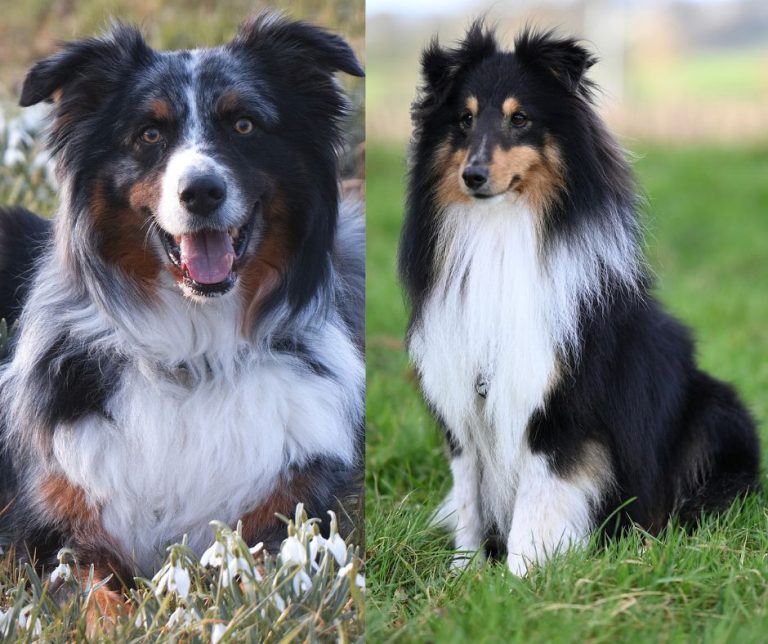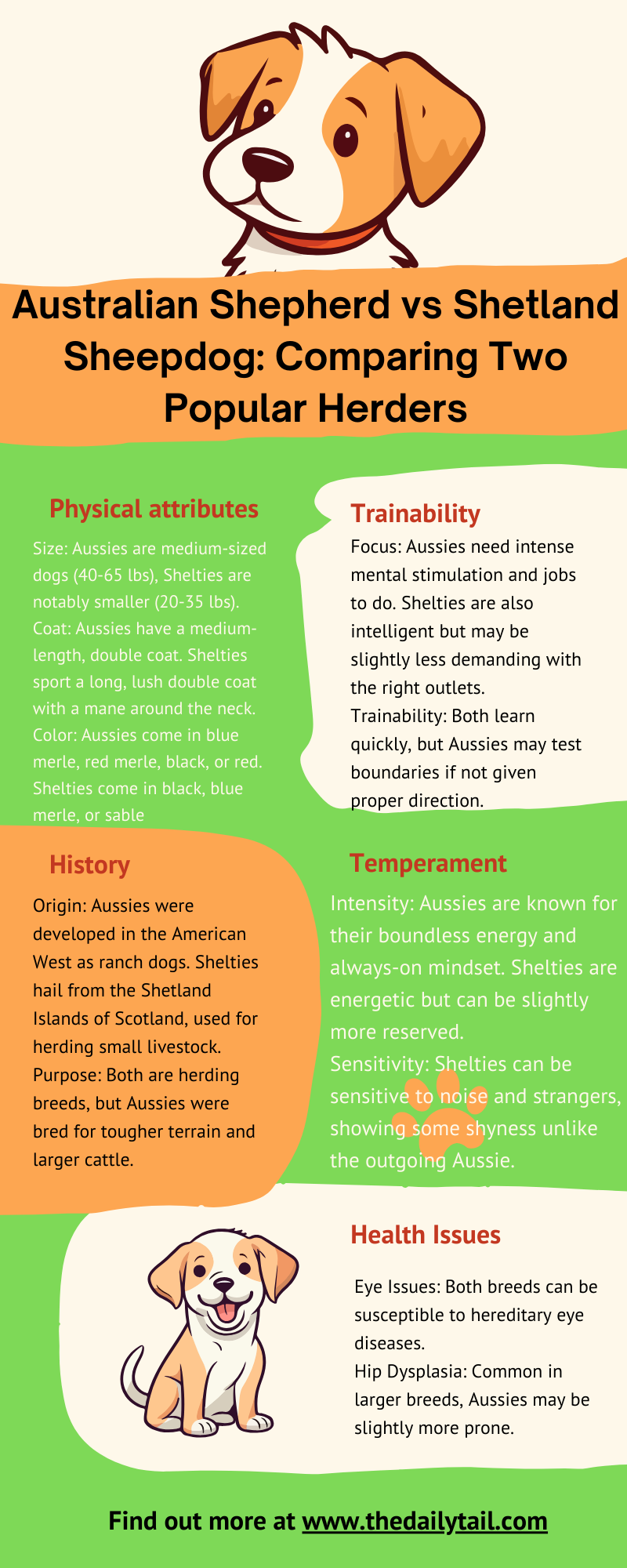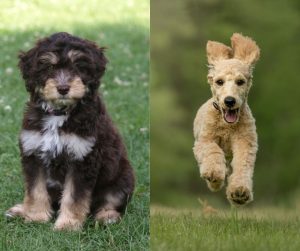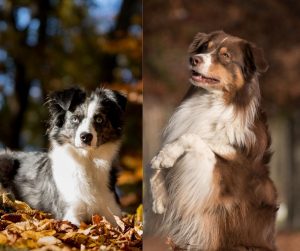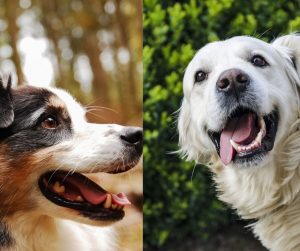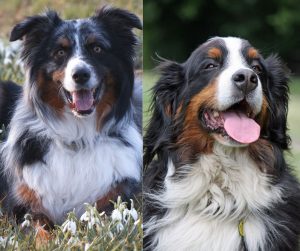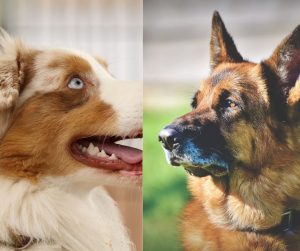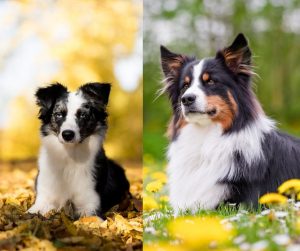If you’ve ever mistaken an Australian Shepherd for a Shetland Sheepdog (like I have!), don’t worry. A lifetime with dogs doesn’t make you immune to their charms. As a lifelong dog enthusiast, I’m fascinated by similar breeds like Aussies and Shelties. Here’s what sets them apart for potential owners
When it comes to choosing a herding breed that fits into family life and adapts well to various living situations, both the Australian Shepherd and the Shetland Sheepdog stand out as popular options. These two breeds share a herding heritage, which is evident in their intelligence, responsiveness, and strong work ethic. However, despite their similarities in purpose and temperament, they have distinct characteristics that set them apart.
Australian Shepherds are medium to large-sized dogs known for their versatility and boundless energy. They typically stand between 20 to 23 inches tall at the shoulder and weigh in at around 50 to 65 pounds. With an above-average lifespan of 13 to 15 years, the breed is well-regarded for its intelligence and intensely work-oriented disposition. They are favored for various dog sports and activities, including agility, where they often excel due to their high energy levels and eagerness to please.
On the other hand, the Shetland Sheepdog, often fondly referred to as the Sheltie, presents a more compact option. They stand at a modest 13 to 16 inches tall and generally weigh between 15 to 25 pounds, making them a suitable choice for those with limited space. Despite their smaller size, Shelties are no less energetic and also possess a playful and loyal temperament. Both breeds demand an adequate amount of exercise and mental stimulation, a testament to their shared herding roots.
Let’s take a look at the Australian Shepherd vs Shetland Sheepdog dog breed comparison.
Breed Origins
The Australian Shepherd and Shetland Sheepdog are both herding breeds with distinct histories reflective of their origins in different parts of the world. These intelligent and agile dogs have evolved to adeptly manage livestock, yet their breed development diverged significantly across continents.
Australian Shepherd History
The Australian Shepherd, despite its name, has its roots in the western United States rather than Australia. It emerged in the 19th century and is believed to have been named for the imported sheep from Australia that they herded. The breed is known for its versatility and skill in herding not only sheep but also cattle, and it became a valuable asset to American ranchers and cowboys. In the US, some people call it the American Shepherd, or Miniature American Shepherd. But it is basically the same thing.
- Place of Origin: Western United States
- Original Purpose: Herding livestock, particularly sheep and cattle
- Recognition: American Kennel Club, known for its work with American ranchers
Shetland Sheepdog History
The Shetland Sheepdog, affectionately known as the Sheltie, hails from the rugged and remote Shetland Islands of Scotland. Originally bred to herd sheep, poultry, and ponies on the islands, they share ancestry with the Collie. The Sheltie was formally recognized by The Kennel Club in 1909, and despite its small size, the breed is known for its hard work ethic and keen intelligence.
- Place of Origin: Shetland Islands, Scotland
- Original Purpose: Herding sheep, poultry, and ponies
- Recognition: The Kennel Club (UK), shares ancestry with the Collie
Physical Characteristics
When distinguishing between Australian Shepherds and Shetland Sheepdogs, several physical traits stand out, from their noticeable size differences to the varied coat colors and ear and tail features.Size and Weight
- Australian Shepherd: They typically stand between 18-23 inches in height and weigh about 40-65 pounds, classifying them as medium-sized dogs. Fun fact, you can get a Standard Australian Shepherd Puppy or Miniature Australian Shepherd puppy
- Shetland Sheepdog: Commonly known as Shelties, they are much smaller, standing 13-16 inches tall and weighing approximately 15-25 pounds.
Coat and Colors
Australian Shepherds and Shetland Sheepdogs both possess double coats that offer protection from the elements, but they differ in texture and length:
- Australian Shepherd: Their coat is of medium length and may come in colors such as black, red, blue merle, and red merle.
- Shetland Sheepdog: Shelties have a long, rough coat that comes in colors like sable, ranging from gold to mahogany, black, blue merle, and combinations thereof with varying amounts of white or tan.
Ear and Tail Features
The breeds show distinctive ear and tail features that are often breed hallmarks:
- Australian Shepherd: They typically have triangular ears that break forward and down, and a docked or naturally bobbed tail.
- Shetland Sheepdog: Their ears are small, set high on the head, and typically bend slightly at the tips, while the tail is long and feathered.
Temperament and Behavior
When comparing the Australian Shepherd vs Shetland Sheepdog, it’s important to recognize their distinct personalities and behavioral tendencies. Both breeds share a herding heritage that significantly influences their temperament, making them energetic and devoted companions.Personality Traits
The Australian Shepherd is known for being smart, work-oriented, and energetic. This breed thrives on physical and mental stimulation, showing high levels of obedience when trained properly. They are affectionate and loyal to their families, often forming a strong bond with one specific person.
Shetland Sheepdogs, on the other hand, are playful, energetic, and loyal, sharing similar traits with the Australian Shepherd. They are sensitive and intelligent, often excelling in obedience training. Herding instincts contribute to a protective and territorial demeanor, although they might display shyness around strangers without proper socialization.
Social Behavior with People and Animals
Australian Shepherds are generally friendly and good-natured with people they know, but can be reserved with strangers. Early socialization is crucial for them to become well-adjusted dogs. They tend to be protective of their family, which makes them vigilant watchdogs.
Shetland Sheepdogs exhibit loyalty to their dog owners and are known to be affectionate and playful with household members. Their predisposition to bark makes them excellent watchdogs, often alerting owners of anything unusual. Shelties can coexist peacefully with other pets, especially when socialized from a young age.
Energy and Activity Levels
Both dog breeds possess intense energy levels and require ample exercise to maintain their physical and mental well-being. The Australian Shepherd is high-energy and loves activities like running, hiking, and agility training. Regular vigorous exercise helps to mitigate potential destructive behaviors borne from boredom.
The Shetland Sheepdog also possesses a high energy level, needing daily activity to remain content. While they can adapt to less space than an Australian Shepherd, they still need regular exercise and mental stimulation to prevent anxious or hyperactive behaviors.
Training and Intelligence
When considering the training and intelligence of both the Australian Shepherd and the Shetland Sheepdog, their heritage as herding breeds plays a pivotal role. They are particularly amenable to training, possessing a high level of intelligence that requires engagement to prevent boredom.Ease of Training
Australian Shepherd: With their remarkable intelligence, Australian Shepherds often learn new commands quickly, making them a favorite for obedience training. They are highly trainable and responsive, thriving on positive reinforcement and a clear, consistent training approach.
Shetland Sheepdog: Similarly, Shetland Sheepdogs excel in trainability, showing great enthusiasm for learning and eagerness to please their handler. Their obedience and loyal nature contribute to their reputation as skilled competitors in agility and obedience trials.
Mental Stimulation Needs
Australian Shepherd: This breed necessitates daily mental stimulation. Without it, they may resort to destructive behavior as an outlet for their energy. Challenges such as advanced obedience, agility courses, and puzzle toys are ideal for keeping their minds active.
Shetland Sheepdog: They also require regular mental engagement but are less likely to become destructive if not properly stimulated. Training that incorporates agility or tasks that simulate herding can greatly benefit their cognitive and emotional health.
Herding Instincts
- Australian Shepherd: Their herding instinct is strong, which can sometimes manifest as herding behavior towards children or other pets. An Australian Shepherd’s exercise regime should include activities that channel this instinct productively
- Shetland Sheepdog: They share the instinct to herd, being attentive and responsive to the movement of livestock or other animals. Shetland Sheepdogs can excel in herding trials and activities that cater to their natural tendencies
Exercise and Recreation
Both the Australian Shepherd and the Shetland Sheepdog boast high energy levels, necessitating ample exercise and engagement in various activities or dog sports to maintain their physical and mental health. Finding the right breed from an activity standpoint is quite important.Exercise Requirements
The Australian Shepherd is an active breed that requires at least 2 hours of exercise per day to satisfy its high energy levels. Activities should be diverse and include both mental and physical stimulation. The intensity can be high due to their work-oriented nature.
- Daily exercise needs: 2+ hours
- Intensity: High-energy activities
In contrast, the Shetland Sheepdog is slightly less demanding but still energetic, benefiting from up to an hour of daily exercise. Regular walks and playtime are essential to keep them happy and healthy.
- Daily exercise needs: up to 1 hour
- Intensity: Moderately high-energy activities
Suitable Activities and Sports
For Australian Shepherds:
- Agility training
- Herding trials (their natural instinct)
- Obedience competitions
- Frisbee and fetch games
- Long walks or hikes in varied terrain
Shetland Sheepdogs excel in:
- Agility courses (suitable for their size and intelligence)
- Flyball competitions
- Obedience and rally events
- Herding activities, despite their smaller size
- Interactive games that stimulate their mind and body, like puzzle toys during walks
When selecting activities, it’s essential to consider the dog’s physical abilities and interests to ensure they are both challenged and enjoying the experience.
Health and Lifespan
When considering an Australian Shepherd or a Shetland Sheepdog, prospective dog owners should be aware of the specific health issues each breed may face and their expected lifespans. Proper care and understanding of these aspects are crucial for maintaining the health and well-being of these dogs.
Common Health Issues
Australian Shepherd:
- Hip Dysplasia: A common condition where the hip joint doesn’t fit together perfectly, leading to arthritis or lameness
- Epilepsy: A neurological disorder that can cause seizures in this dog breed
- Progressive Retinal Atrophy (PRA): A genetic eye disorder that can lead to blindness
- Elbow Dysplasia: Similar to hip dysplasia, affecting the elbow joints, potentially causing pain or lameness
Shetland Sheepdog:
- Hip Dysplasia: While smaller, Shelties can also suffer from hip dysplasia, albeit less frequently
- Progressive Retinal Atrophy (PRA): They share this genetic predisposition to eye diseases with Australian Shepherds
- Allergies: They can have sensitivities leading to skin and dietary allergies
- Shedding Season: Shelties have long coats that shed heavily during the season, requiring care to prevent matting and skin issues
Average Lifespan
- Australian Shepherd: They typically live from 12 to 15 years. Their longevity can be influenced by their overall health, care, and genetics
- Shetland Sheepdog: They have a slightly similar lifespan, usually between 12 and 14 years. With appropriate care and attention to their genetic health concerns, Shelties can enjoy a full lifespan
Both breeds will thrive with owners who are committed to their health and who are proactive about preventative care. Regular vet check-ups, a balanced diet, and exercise can greatly influence the longevity and quality of life of both Australian Shepherds and Shetland Sheepdogs.
Grooming and Care
Proper grooming and care are essential for the health and wellbeing of both the Australian Shepherd and the Shetland Sheepdog. These breeds require attention to their luxurious coats, shedding management, and specific dietary needs.
Grooming Needs
Australian Shepherd: This breed has a medium-length coat that is resistant to dirt and water, making it moderately easy to maintain. They typically require brushing once or twice a week to prevent mats and tangles. During the spring and fall shedding seasons, more frequent brushing helps control excess hair.
- Essential Grooming Tasks:
- Brushing: Weekly, increases to daily during shedding seasons
- Bathing: Occasional, every few months or as necessary
- Nail Trimming: Monthly, to prevent overgrowth and splitting
- Ear Cleaning: Monthly, to prevent infection
Shetland Sheepdog: The Shetland Sheepdog sports a long, double coat that needs more regular grooming to avoid matting. Owners should brush their Sheltie’s coat several times a week.
- Essential Grooming Tasks:
- Brushing: Several times per week
- Bathing: Every 4-6 weeks or as needed
- Nail Trimming: Monthly
- Ear Cleaning: Regular checks and cleaning to prevent buildup
Shedding and Allergies
Both Australian Shepherds and Shetland Sheepdogs experience periods of heavier shedding, commonly in the spring and fall. This may present more of a challenge for individuals with allergies, as shedding can increase the amount of pet dander in the home.
- Shedding Management:
- Regular brushing to remove loose hair
- Use of an undercoat rake during peak shedding
- Vacuuming living spaces more frequently to reduce allergens
Diet and Nutrition
The dietary needs of the Australian Shepherd and the Shetland Sheepdog can differ based on their energy levels and size. Both breeds thrive on high-quality dog food that meets their respective nutritional requirements.
Australian Shepherd:
- Activity Level: High energy, requires more calories
- Common Diet: Protein-rich food with moderate fat content
Shetland Sheepdog:
- Activity Level: Moderately active, needs fewer calories than the Australian Shepherd
- Common Diet: Balanced diet tailored to smaller breed needs
Living Environment
When considering the living environments for Australian Shepherds and Shetland Sheepdogs, it is crucial to understand their space and family compatibility needs. These breeds possess distinct characteristics that dictate their adaptability to various living situations and their interactions within a family setting.Adaptation to Living Spaces
Australian Shepherds, commonly referred to as Aussies, thrive in environments where they can get plenty of exercise and mental stimulation. They are not ideally suited for apartment living due to their high energy levels and need for space to run and play. As herding dogs, they excel in settings where they have a specific purpose, such as on a farm or in active households that can provide them with tasks and training.
Shetland Sheepdogs, or Shelties, are smaller in size and can adapt better to smaller living spaces, including apartments, as long as their exercise needs are met. They do well with regular walks and playtime. However, they too benefit from having a yard or open areas where they can expel energy. Socialization is important for both breeds to prevent issues such as excessive barking or shyness, with the Kennel Club emphasizing early exposure to various environments and people.
Compatibility with Families
When comparing Australian Shepherd vs Shetland Sheepdog, both are known for being great family dogs. Their intelligence and easy-to-train nature make them ideal companions in homes with or without children.
- Australian Shepherds are notably loyal and protective, often forming strong bonds with family members. They are also known for being good with children but require supervision due to their herding instincts which might lead to the herding of small kids
- Shetland Sheepdogs have a gentle disposition and are affectionate with their families, making them excellent family pets. Their playful yet gentle demeanor ensures they fit well in homes with respectful children
Both breeds demand engagement and thrive in households where they can be part of the family dynamic, whether through play or through activities that challenge their intellect and agility. Regular socialization and inclusion in family activities are vital for these breeds to maintain their well-being and to prevent them from feeling isolated or neglected.
Breed Comparison
When comparing the Australian Shepherd and the Shetland Sheepdog, several key distinctions stand out, including size, temperament, and their roles as companions and herders. Both breeds share appealing qualities such as alertness and playfulness, making them popular among dog enthusiasts. So, let’s try to find the right breed for you and your family.Distinct Differences
Australian Shepherds, commonly known as Aussies, are larger than Shetland Sheepdogs, with a notable size difference. Aussies typically weigh between 40 to 65 pounds and stand about 18 to 23 inches tall. They serve as dedicated herders and are known for their intelligence and energy.
| Trait | Australian Shepherd | Shetland Sheepdog |
|---|---|---|
| Height | 18-23 inches | 13-16 inches |
| Weight | 40-65 pounds | 15-25 pounds |
| Role | Versatile herder | Focused herder and watchdog |
Shetland Sheepdogs, or Shelties, are smaller, weighing 15 to 25 pounds and standing 13 to 16 inches tall. Although they share the herding instinct with Aussies, Shelties are also excellent watchdogs, combining their herding skills with a strong sense of alertness.
Similar Appealing Qualities
Both Australian Shepherds and Shetland Sheepdogs possess a charming rough coat, often featuring merle or mottled patterns. They are intelligent, making training a rewarding experience for both the dog and the owner. Their playfulness and affectionate nature make them ideal companions.
- Coat Type: Both breeds have thick, double-layer coats suitable for various weather conditions
- Playfulness: They are engaging and enjoy interactive games, which makes them great playmates for children and adults alike
- Companionship: Known for their loyalty, both Aussies and Shelties thrive in an environment where they can bond closely with their families
These dogs’ shared traits and their differences contribute to their unique appeal to different lifestyles and preferences.
Acquisition and Price
When considering adding either an Australian Shepherd puppy or a Shetland Sheepdog puppy to one’s family, it is essential to understand the financial implications of both the initial purchase and the ongoing costs of ownership.
Purchasing a Puppy
The Australian Shepherd, a highly energetic and intelligent breed, typically comes with a price tag ranging from $1,000 to upwards of $1,500 for puppies, with variations depending on factors like breeder reputation and bloodline quality. On the other hand, prices for a Shetland Sheepdog puppy can also be within a similar bracket, generally between $500 and $1,500. These costs reflect the breeder’s investment in the health, genetics, and care of the puppies prior to purchase.
Long-Term Ownership Costs
Beyond the initial purchase, the long-term costs for both breeds include food, veterinary care, grooming, and training. An Australian Shepherd may incur:
- Food: High-quality diet tailored to high energy levels
- Veterinary Care: Regular check-ups, vaccinations, and potential hereditary condition care
- Grooming: Requires regular brushing; more frequent during shedding seasons
- Training: Highly recommended due to intelligence and energy levels
Similarly, a Shetland Sheepdog‘s costs can be expected to comprise:
- Food: Appropriately portioned to their smaller size compared to the Australian Shepherd
- Veterinary Care: Similar needs for regular medical attention and possible breed-specific issues
- Grooming: Shelties have a thick double coat that needs regular grooming
- Training: Intelligent and trainable with a need for mental stimulation
Both breeds are known for their intelligence and the ability to be great family pets, but prospective owners should prepare for the financial commitment that comes with adding these dogs to their lives.

